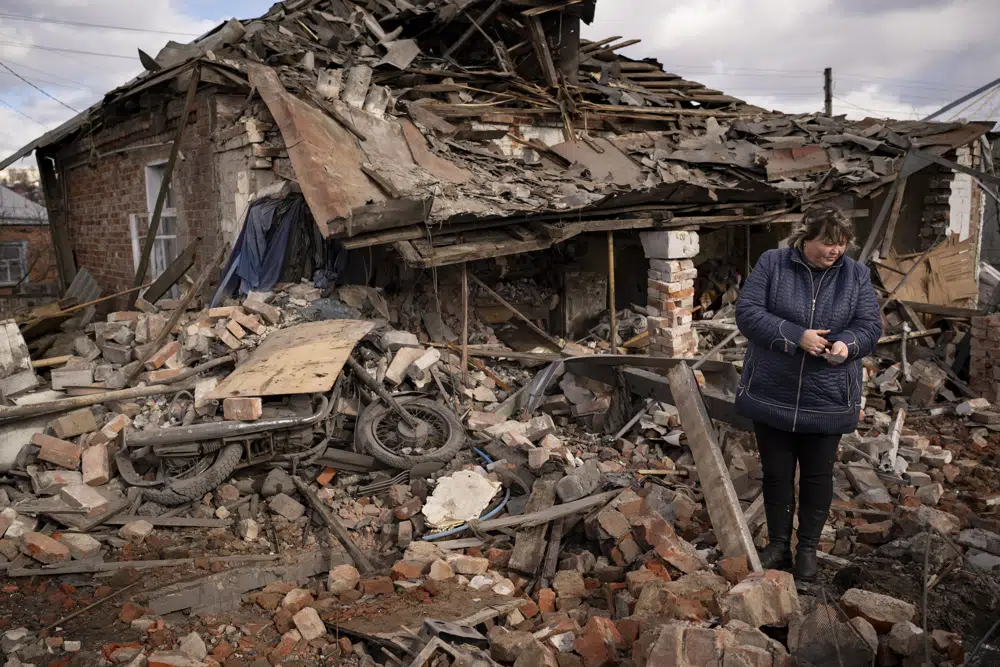FILE – A woman holds a piece of shrapnel standing in the rubble of a house where Ukrainian servicemen were sheltering which destroyed by a Russian S-300 rocket strike, in Kupiansk, Ukraine, Monday, Feb. 20, 2023. Grueling artillery battles have stepped up in recent weeks in the vicinity of Kupiansk, a strategic town on the eastern edge of Kharkiv province by the banks of the Oskil River as Russian attacks intensifying in a push to capture the entire industrial heartland known as the Donbas, which includes the Donetsk and the Luhansk provinces. (AP Photo/Vadim Ghirda, File)
KYIV, Ukraine (AP) — Russian President Vladimir Putin on Tuesday ordered officials to tighten control of the border with Ukraine after a spate of drone attacks that Russian authorities blamed on Kyiv delivered a new challenge to Moscow more than a year after its full-scale invasion of its neighbor.
One drone crashed just 100 kilometers (60 miles) away from Moscow in an alarming development for Russian defenses.
While Putin didn’t refer to any specific attacks in a speech in the Russian capital, his comments came hours after drone attacks targeted several areas in southern and western Russia and authorities closed the airspace over St. Petersburg in response to what some reports said was a drone.
Also Tuesday, several Russian television stations aired a missile attack warning that officials blamed on a hacking attack.
The drone attacks caused no casualties but provoked a security stir as the war with Kyiv stretched into its second year last week.
Ukrainian officials didn’t immediately claim responsibility for the attacks, but they similarly avoided directly acknowledging responsibility for previous strikes and sabotage while emphasizing Ukraine’s right to hit any target in Russia following the full-scale invasion that began last year.
A flurry of drone attacks on Monday night and Tuesday morning targeted regions inside Russia along the border with Ukraine and deeper into the country, according to local Russian authorities.
A drone fell near the village of Gubastovo, 100 kilometers (60 miles) from Moscow, Andrei Vorobyov, governor of the region surrounding the Russian capital, said in an online statement.
The drone didn’t inflict any damage, Vorobyov said. He didn’t specifically describe the drone as Ukrainian, but said that it likely targeted “a civilian infrastructure object.”
Pictures of the drone showed it was a Ukrainian-made type. It reportedly has a range of up to 800 kilometers (nearly 500 miles), but isn’t capable of carrying a large load of explosives.
Russian forces early Tuesday shot down a Ukrainian drone over the Bryansk region, local Gov. Aleksandr Bogomaz said in a Telegram post. He said there were no casualties.
Three drones also targeted Russia’s Belgorod region on Monday night, with one flying through an apartment window in its namesake capital, local authorities reported. Regional Gov. Vyacheslav Gladkov said the drones caused minor damage to buildings and cars but no casualties.
The Russian Defense Ministry said that Ukraine used drones to attack facilities in the Krasnodar region and neighboring Adygea. It said the drones were brought down by electronic warfare assets, adding that one of them crashed into a field and another diverted from its designated flight path and missed an infrastructure facility it was supposed to attack.
While Ukrainian drone strikes on the Russian border regions of Bryansk and Belgorod that lie north of Ukraine’s Sumy region aren’t unusual, the hits on the Krasnodar and Adygea regions further south are noteworthy.
A fire broke out at an oil depot in Russia’s Krasnodar region on Monday, Russia’s state RIA Novosti agency reported. Russian Telegram channels claimed that two drones exploded near the depot.
While some Russian commentators described the drone attacks as an attempt by Ukraine to showcase its capability to strike areas deep behind the lines, foment tensions in Russia and rally the Ukrainian public, some Russian war bloggers described the raids as a possible rehearsal of a bigger, more ambitious attack.
Last year, Russian authorities repeatedly reported shooting down Ukrainian drones over annexed Crimea. In December, the Russian military said Ukraine used drones to hit two bases for long-range bombers deep inside Russian territory.
Separately, the local government of St. Petersburg — Russia’s second-largest city about 1,300 kilometers (800 miles) north of the border with Ukraine — said early Tuesday that it was temporarily halting all flight departures and arrivals at the city’s main airport, Pulkovo. It didn’t give a reason for the move.
Hours earlier, unconfirmed reports on Russia’s Telegram social network referred to the airspace over St. Petersburg being shut down and to Russian warplane overflights. It wasn’t immediately clear whether this was connected to the alleged uptick in drone attacks in Russia’s south.
The Russian military said its air defense forces in Western Russia conducted drills on “detection, interception and identification” of enemy targets in its airspace, and in coordination with civilian air traffic services in an emergency situation.
The Russian Defense Ministry didn’t specifically mention St. Petersburg, but its statement appeared designed to explain the temporary closure of the airspace.
Kremlin spokesman Dmitry Peskov refused to comment on the situation in St. Petersburg, urging reporters to wait for details from the country’s aviation authorities or the military.
He noted, however, that Putin had “full information” on the situation.
Speaking at Russia’s main security agency, the FSB, Putin urged the service to tighten security on the Ukraine border.
Russian media reported on Tuesday morning that in several Russian regions an air raid alarm interrupted the programming of several TV channels and radio stations.
Footage posted by some news sites showed TV sets displaying a yellow sign with a person heading to a bomb shelter, with a female voice repeating: “Attention! Air raid alarm. Everyone should head to a shelter immediately.”
Russia’s Emergency Ministry said in an online statement that the announcement was a hoax “resulting from a hacking of the servers of radio stations and TV channels in some regions of the country.”
Inside Ukraine, authorities said Tuesday that at least two civilians were killed by renewed Russian shelling in the southern city of Kherson and surrounding villages and 17 more were wounded in fighting over the previous 24 hours.
The fiercest fighting continued to be in eastern areas of Ukraine, where Russia wants control over all four of the provinces it illegally annexed in September.
Ukrainian officials said that Russian forces have deployed additional troops and equipment, including modern T-90 tanks, in those areas.
Meanwhile, satellite photos analyzed by The Associated Press appear to show a Beriev A-50 early warning aircraft was parked at a Belarus air base just before a claimed attack by partisans there.
Images from Planet Labs PBC shows the A-50, a late Soviet era aircraft known for its distinctive rotodome above its fuselage, parked at the northern apron of the Machulishchy Air Base near Minsk, Belarus’ capital, on Feb. 19.
A lower-resolution image taken on Feb. 23 shows a similarly-shaped aircraft still parked there, though heavy cloud cover has blocked any images since.
Belarusian opposition organization BYPOL claimed that guerrillas damaged the A-50 in an attack Sunday.
The Associated Press has been unable to independently confirm the claimed attack, which both Belarus and Russia have yet to acknowledge.
___ Jon Gambrell contributed to this report from Dubai, United Arab Emirates.
Copyright 2021 Associated Press. All rights reserved.
Source: https://apnews.com/article/russia-ukraine-war-attacks-drones-e02372ef4b84fc3b4cf6afe8ed141a77










































